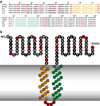Plasminogen receptors: the first quarter century
- PMID: 23532575
- PMCID: PMC3938387
- DOI: 10.1055/s-0033-1334483
Plasminogen receptors: the first quarter century
Abstract
The interaction of plasminogen with cell surfaces results in promotion of plasmin formation and retention on the cell surface. This results in arming cell surfaces with the broad-spectrum proteolytic activity of plasmin. Over the past quarter century, key functional consequences of the association of plasmin with the cell surface have been elucidated. Physiologic and pathophysiologic processes with plasmin-dependent cell migration as a central feature include inflammation, wound healing, oncogenesis, metastasis, myogenesis, and muscle regeneration. Cell surface plasmin also participates in neurite outgrowth and prohormone processing. Furthermore, plasmin-induced cell signaling also affects the functions of inflammatory cells, via production of cytokines, reactive oxygen species, and other mediators. Finally, plasminogen receptors regulate fibrinolysis. In this review, we highlight emerging data that shed light on longstanding controversies and raise new issues in the field. We focus on (1) the impact of the recent X-ray crystal structures of plasminogen and the development of antibodies that recognize cell-induced conformational changes in plasminogen on our understanding of the interaction of plasminogen with cells; (2) the relationship between apoptosis and plasminogen binding to cells; (3) the current status of our understanding of the molecular identity of plasminogen receptors and the discovery of a structurally unique novel plasminogen receptor, Plg-RKT; (4) the determinants of the interplay between distinct plasminogen receptors and cellular functions; and (5) new insights into the role of colocalization of plasminogen and plasminogen activator receptors on the cell surface.
Thieme Medical Publishers 333 Seventh Avenue, New York, NY 10001, USA.
Figures

References
-
- Miles LA, Plow EF. Binding and activation of plasminogen on the platelet surface. J Biol Chem. 1985;260(7):4303–4311. - PubMed
-
- Stricker RB, Wong D, Tak Shiu D, Reyes PT, Shuman MA. Activation of plasminogen by tissue plasminoagen activator on normal and thrombasthenic platelets: Effects on surface proteins and platelet aggregation. Blood. 1986;68(1):275–280. - PubMed
-
- Hajjar KA, Harpel PC, Jaffe EA, Nachman RL. Binding of plasminogen to cultured human endothelial cells. J Biol Chem. 1986;261(25):11656–11662. - PubMed
-
- Ellis V, Behrendt N, Dano K. Plasminogen activation by receptor-bound urokinase. A kinetic study with both cell-associated and isolated receptor. J Biol Chem. 1991;266(19):12752–12758. - PubMed
Publication types
MeSH terms
Substances
Grants and funding
LinkOut - more resources
Full Text Sources
Other Literature Sources
Miscellaneous

